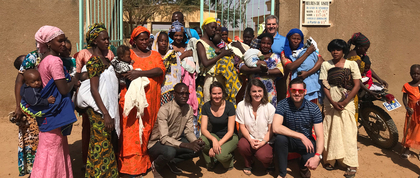
Dr. Jack Caravanos reports from Matam where he mentored the
Senegal 2018 Capstone Team.
When Prof. Chris Dickey first asked me to accompany four Capstone students studying malnutrition to eastern Senegal, I was quick to remind him that I’m an environmental scientist, not a nutrition expert. So what could I possibly have to offer them? The Capstone team -- Leanne Demery, Allison Mercurio, Consolata Mogeni and Mark Stratton – was collecting data with the help of the World Food Programme for a bottleneck analysis of food delivery systems. This methodology was pioneered by our own Prof. Rudolf Knippenberg, who presents it in his courses.
According to various WFP and UNICEF reports, severe acute malnutrition (SAM) continues to be prevalent in the eastern region of Matam, with rates over 20%. What factors cause this alarmingly high rate, and what are the obstacles (bottlenecks) to delivering food and food supplements to this community of 680,000 people? To find out, the team visited a number of villages and spoke with community leaders, families, government officials and health officers to collect the data to answer these questions. It was interesting to watch the learning process the students undertook in order to come up with new ideas and approaches to an old problem.
One interesting finding involved the rather large migrating populations in the region. Entire families move with their cattle across long distances following rich grazing fields. Is this where SAM and MAM (moderately acute malnutrition) begins? If so, how do you get food to thousands of individually migrating families? The students grappled with these questions throughout their Capstone trip.
Having travelled to many low- and middle-income countries worldwide doing environmental site assessments, I have a lot of experience working with UN agencies, NGOs, and health ministries. But I was unprepared for the tremendous learning opportunity this trip presented to me personally (full disclosure: I never took a nutrition course in college). Terms like SAM, MAM, RUTF, RUSF, wasting, stunting, plumby nut, plumby dough, and IYCF were as foreign to me as POPs (persistent organic pollutants) are to a nutrition major. But that was the thrill: to learn. And after almost two weeks with the team, the WFP staff and the community, I was clearly the bigger winner on this mission.
Of course, no Caravanos trip is complete without a visit to a toxic waste site (and, in this case, several of them). Pure Earth, the NGO I partner with, has identified 34 toxic waste sites in Senegal, so I had my pick. First I visited the infamous Thiaroye Sur Mer site, where improper lead-acid battery recycling killed 18 children in 2009. Using a portable heavy metals detector, our local Pure Earth team was able to confirm that the cleanup was successful and the risk was eliminated. Next I headed to an obsolete pesticide storage facility, where concentrated pesticides were discharged throughout. Lots of cleanup was needed there and FAO (the UN Food and Agriculture Organization), which directs this global problem, has its work cut out for it.
But nothing was as awe-inspiring and memorable as Mbeubeuss, the local garbage landfill of Dakar. Yes, I love visiting garbage dumps and never refuse the opportunity! And Mbeubeuss is one of a kind. About 30 government officials manage a site larger than Prospect Park, Brooklyn, yet over 30,000 people live off the trash that’s deposited there every day. Everything seems to be sorted, bagged and sold off: sandals, chairs, bottles, rope, metals. Even discarded food is collected for the cattle “grazing” at the landfill. Sorry, I just don’t have enough space to present the entire picture, but a Caravanos YouTube video is likely coming sometime in the future.
What else is there to say about Senegal? The country is beautiful, and the people were friendly and accommodating. Dakar is a very nice city with lots to offer (including traffic jams). As for eastern Senegal, it’s flat, dry and wide open, with wild camels running about.
All too soon, my adventure came to an end. I look forward to more Capstone projects in the future, and recommend that my colleagues “just say yes” if they’re asked to accompany Capstone students to another country. Opportunities like this don’t come around often, and the memories last a lifetime. Plus, it’s quite likely you’ll learn more than the students do!
Jack Caravanos, PhD
Clinical Professor of Environmental Public Health Sciences